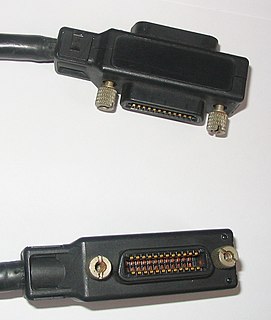Federal Information Processing Standards (FIPS) are publicly announced standards developed by the United States federal government for use in computer systems by non-military government agencies and government contractors.

IEEE 488 is a short-range digital communications 8-bit parallel multi-master interface bus specification. IEEE 488 was created as HP-IB and is commonly called GPIB. It has been the subject of several standards.
The Institute of Radio Engineers (IRE) was a professional organization which existed from 1912 until December 31, 1962. On January 1, 1963 it merged with the American Institute of Electrical Engineers (AIEE) to form the Institute of Electrical and Electronics Engineers (IEEE).

The National Electrical Code (NEC), or NFPA 70, is a regionally adoptable standard for the safe installation of electrical wiring and equipment in the United States. It is part of the National Fire Code series published by the National Fire Protection Association (NFPA), a private trade association. Despite the use of the term "national", it is not a federal law. It is typically adopted by states and municipalities in an effort to standardize their enforcement of safe electrical practices. In some cases, the NEC is amended, altered and may even be rejected in lieu of regional regulations as voted on by local governing bodies.

Robert Gray Gallager is an American electrical engineer known for his work on information theory and communications networks. He was elected an IEEE Fellow in 1968, a member of the National Academy of Engineering (NAE) in 1979, a member of the National Academy of Sciences (NAS) in 1992, a Fellow of the American Academy of Arts and Sciences (AAAS) in 1999. He received the Claude E. Shannon Award from the IEEE Information Theory Society in 1983. He also received the IEEE Centennial Medal in 1984, the IEEE Medal of Honor in 1990 "For fundamental contributions to communications coding techniques", the Marconi Prize in 2003, and a Dijkstra Prize in 2004, among other honors. For most of his career he was a professor of electrical engineering and computer science at the Massachusetts Institute of Technology.

The National Fire Protection Association (NFPA) is an international nonprofit organization devoted to eliminating death, injury, property and economic loss due to fire, electrical and related hazards. In 2018, the NFPA claims to have 50,000 members and 9,000 volunteers working with the organization through its 250 technical committees.
The CSA Group, is a standards organization which develops standards in 57 areas. CSA Group publishes standards in print and electronic form and provides training and advisory services. CSA Group is composed of representatives from industry, government, and consumer groups.
The American Institute of Electrical Engineers (AIEE) was a United States-based organization of electrical engineers that existed from 1884 through 1962. On January 1, 1963 it merged with the Institute of Radio Engineers (IRE) to form the Institute of Electrical and Electronics Engineers (IEEE).
Irving Stoy Reed was a mathematician and engineer. He is best known for co-inventing a class of algebraic error-correcting and error-detecting codes known as Reed–Solomon codes in collaboration with Gustave Solomon. He also co-invented the Reed–Muller code.
NFPA 70E, titled Standard for Electrical Safety in the Workplace, is a standard of the National Fire Protection Association (NFPA). The document covers electrical safety requirements for employees. The NFPA is best known for its sponsorship of the National Electrical Code.
Engineering ethics is the field of system of moral principles that apply to the practice of engineering. The field examines and sets the obligations by engineers to society, to their clients, and to the profession. As a scholarly discipline, it is closely related to subjects such as the philosophy of science, the philosophy of engineering, and the ethics of technology.

The International Municipal Signal Association (IMSA) is one of the two main professional organizations contributing input to the Federal Highway Administration (FHWA) in revising and developing highway standards concerning traffic signals and control devices.
The American Engineers' Council for Professional Development or simply the Engineers' Council for Professional Development (ECPD), established in June 1932, was an engineering professional body dedicated to the education, accreditation, regulation and professional development of the engineering professionals and students in the United States. ECPD grew and has changed its name to ABET, Inc. and its focus solely to accreditation.
Bishnu S. Atal is an Indian physicist and engineer. He is a noted researcher in acoustics, and is best known for developments in linear predictive coding (LPC) and code-excited linear prediction (CELP) with Manfred R. Schroeder.
IEEE 1547 is a standard of the Institute of Electrical and Electronics Engineers meant to provide a set of criteria and requirements for the interconnection of distributed generation resources into the power grid.
The IEEE Instrumentation and Measurement Society is a professional society of the Institute of Electrical and Electronics Engineers (IEEE). The society's fields of interest, according to its website, include metrology, analog and digital electronic instruments, systems and standards for measuring and recording electrical quantities, instrumentation and transducers for measurement of non-electrical variables, calibration and uncertainty, instruments with automated control and analysis functions, safety instrumentation, and new technology applications.







